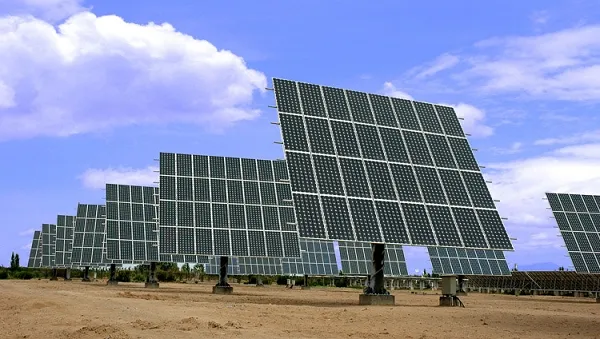为增进大家对太阳能电池的认识,本文将基于两点介绍有机太阳能电池:1、有机太阳能电池结构原理,2、有机太阳能电池应用前景。如果你对太阳能电池具有兴趣,不妨继续往下阅读哦。
In order to improve everyone's understanding of solar cells, this article will introduce organic solar cells based on two points: 1, organic solar cells structure principle, 2, organic solar cells application prospects. If you're interested in solar cells, read on.
Structure principle of organic solar cell
有机太阳能电池结构原理
太阳能电池,是一种利用太阳光直接发电的光电半导体薄片,又称为“太阳能芯片”或“光电池”,它只要被满足一定照度条件的光照度,瞬间就可输出电压及在有回路的情况下产生电流。在物理学上称为太阳能光伏(Photovoltaic,缩写为PV),简称光伏。而有机太阳能电池,便是太阳能电池中的一种。
Solar cell is a photoelectric semiconductor sheet that uses sunlight to generate electricity directly, also known as "solar chip" or "photocell", it can output voltage and generate current in the case of a loop as long as it is met with a certain illuminance condition. In physics, it is called solar Photovoltaic (Photovoltaic, abbreviated as PV), referred to as photovoltaic. Organic solar cells are one kind of solar cells.

有机太阳能电池,顾名思义,就是由有机材料构成核心部分的太阳能电池。主要是以具有光敏性质的有机物作为半导体的材料,以光伏效应而产生电压形成电流, 实现太阳能发电的效果。有机太阳能电池作为新型太阳能电池器件,具备柔性、质量轻、颜色可调、可溶液加工、大面积印刷制备等特点,是目前太阳能电池研究领域的热点。但是效率低是限制其大规模应用的主要原因。下面,我们正式看一下有机太阳能电池的结构原理。
Organic solar cells, as the name suggests, are solar cells that are composed of organic materials. It is mainly based on the photosensitive organic matter as a semiconductor material, and the photovoltaic effect generates voltage and forms current to achieve the effect of solar power generation. As a new type of solar cell device, organic solar cells have the characteristics of flexibility, light weight, adjustable color, solution processing, large area printing preparation, etc., and are currently the hot spot in the field of solar cell research. However, low efficiency is the main reason limiting its large-scale application. Next, let's take a formal look at the structural principle of organic solar cells.
有机太阳能电池原理
principle
有机太阳能电池以具有光敏性质的有机物作为半导体的材料,以光伏效应而产生电压形成电流。主要的光敏性质的有机材料均具有共轭结构并且有导电性,如酞菁化合物、卟啉、菁(cyanine)等。
Organic solar cells use photosensitive organic matter as a semiconductor material, and generate voltage to form current through photovoltaic effect. The main photosensitive organic materials have conjugated structures and electrical conductivity, such as phthalocyanine compounds, porphyrins, cyanine and so on.
有机太阳能电池结构
structure
有机太阳能电池按照半导体的材料可以分为单质结结构、P-N 异质结结构、染料敏化纳米晶结构。
According to the semiconductor material, organic solar cells can be divided into simple structure, P-N heterostructure, dye sensitized nanocrystalline structure.
单质结结构
homojunction
单质结结构是以Schotty 势垒为基础原理而制作的有机太阳能电池。其结构为玻璃/金属电极/染料/金属电极,利用了两个电极的功函不同,可以产生一个电场,电子从低功函的金属电极传递到高功函电极从而产生光电流。由于电子—空穴均在同一种材料中传递,所以其光电转化率比较低。
The elemental junction structure is an organic solar cell based on Schotty barrier. Its structure is glass/metal electrode/dye/metal electrode, using the work function of the two electrodes is different, can produce an electric field, electrons from the low work function of the metal electrode to the high power communication electrode to produce photocurrent. Due to the electron-hole transfer in the same material, the photoelectric conversion rate is relatively low.
P—N 异质结结构
heterojunction
P—N 异质结结构是指这种结构具有给体-受体(N 型半导体与P 型半导体)的异质结结构,结构如图5。其中半导体的材料多为染料,如酞菁类化合物、苝四甲醛亚胺类化合物,利用半导体层间的D/A界面(Donor——给体,Acceptor——受体)以及电子—空穴分别在不同的材料中传递的特性,使分离效率提高。Elias Stathatos 等人结合无机以及有机化合物的优点制得的太阳能电池光电转化率在5%~6%。
P-n heterostructure refers to the heterostructure of this structure with donor-acceptor (N-type semiconductor and P-type semiconductor), and the structure is shown in Figure 5. Among them, the semiconductor materials are mostly dyes, such as phthalocyanine compounds and perylene tetraformaldehyde imines. The D/A interface between the semiconductor layers (donor-donor, acceptor-acceptor) and the electron-hole transmission characteristics in different materials are used to improve the separation efficiency. Elias Stathatos et al. combined the advantages of inorganic and organic compounds to produce solar cells with a photoelectric conversion rate of 5% to 6%.
NPC染料敏化纳米晶
NPC
染料敏化太阳能电池(DSSC)主要是指以染料敏化的多空纳米结构TiO2 薄膜为光阳极的一类太阳能电池。它是仿生植物叶绿素光合作用原理的太阳能电池。而NPC 太阳能电池可选用适当的氧化还原电解质从而使光电效率提高,一般可稳定于10%,并且纳米晶TiO2 制备简便,成本低廉,寿命可观,具有不错的市场前景。
Dye-sensitized solar cells (DSSC) mainly refer to a of solar cells with dye-sensitized multi-space nanostructured TiO2 film as the photoanode. It is a solar cell that mimics the principle of chlorophyll photosynthesis in plants. NPC solar cells can use appropriate REDOX electrolytes to improve the photoelectric efficiency, generally stable at 10%, and nanocrystalline TiO2 preparation is simple, low cost, considerable life, has a good market prospects.
Application prospect of organic solar cells
有机太阳能电池应用前景
已知太阳光照射到地球上的平均能量密度为1376W/平方米,假设能量转化率已达到为30%。城市每个三口之家每天的平均用电量为3kw·h,平均太阳光照时间4h,则只需不足2 平方米太阳能电池板即可为之提供充足的电力。另一方面,家庭电路最大熔断电流一般在20A 左右,最大瞬时功率4400W。达到此瞬时功率只需10 平方米左右的太阳能电池板即可。
It is known that the average energy density of sunlight hitting the Earth is 1376W/ m2, assuming that the energy conversion rate has reached 30%. With an average electricity consumption of 3kw·h per day for each family of three in the city and an average sunlight duration of 4h, less than 2 square meters of solar panels are needed to provide sufficient electricity. On the other hand, the maximum fusing current of the home circuit is generally about 20A, and the maximum instantaneous power is 4400W. To achieve this instantaneous power only about 10 square meters of solar panels can be.

工厂、学校的等大型耗电场所则依靠水利、风力发电、核能发电等途径获得电力。这种多层次的供电体系既可以保证社会正常运转,也充分利用了清洁能源。
Factories, schools and other large power consumption places rely on water conservancy, wind power generation, nuclear power generation and other ways to obtain electricity. This multi-level power supply system can not only ensure the normal operation of society, but also make full use of clean energy.
由上述计算我们也以大致看出,太阳能电池只能作为辅助能源,而不能作为主要能源使用。因为太阳能虽然总量很大,但受场地及成本等因素限制不可能达到很高的功率,难以满足高耗电场所的电力需求,而且太阳能受天气情况等因素影响较大,并不十分稳定,所以利用它做主要能源是不现实的。
From the above calculation, we can also roughly see that solar cells can only be used as an auxiliary energy source, but not as a main energy source. Because although the total amount of solar energy is large, it is impossible to reach a high power due to site and cost and other factors, it is difficult to meet the power demand of high-power places, and solar energy is greatly affected by weather conditions and other factors, and is not very stable, so it is unrealistic to use it as the main energy source.